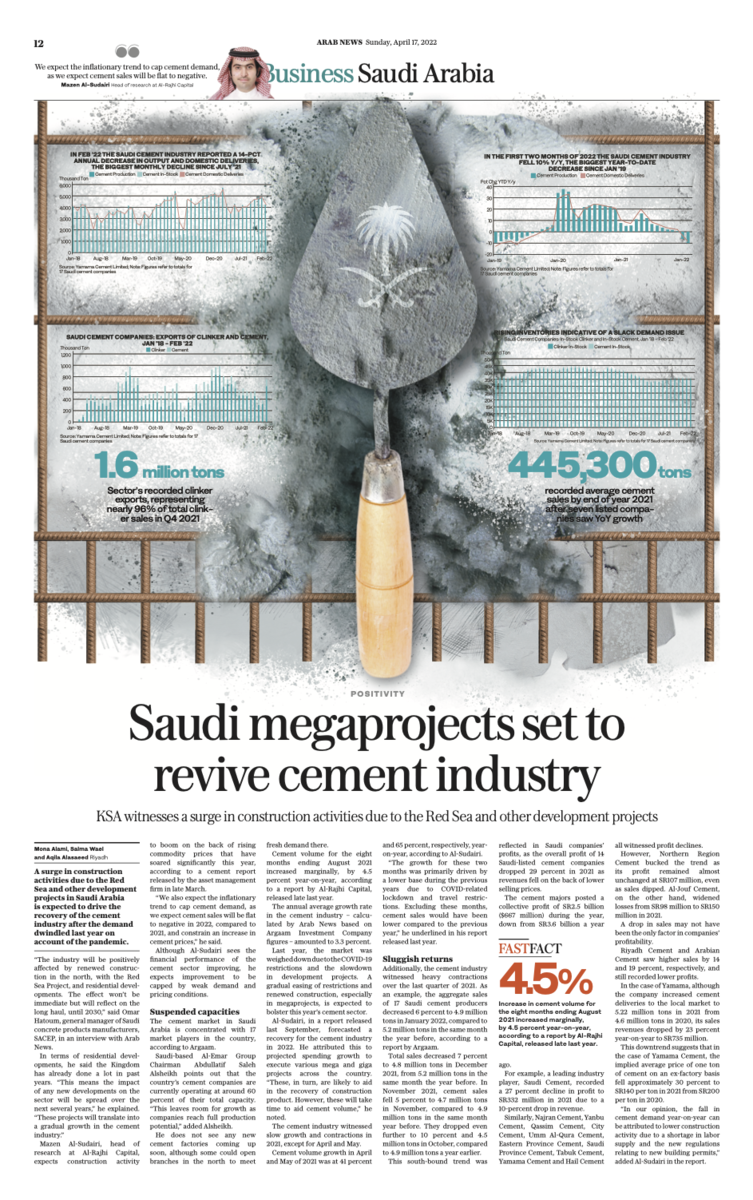RIYADH: A surge in construction activities due to The Red Sea Development Co., AMAALA and other development projects in Saudi Arabia such as NEOM and Qiddiya is expected to drive the recovery of the cement industry after the demand dwindled last year and early this year on account of the pandemic.
“The industry will be positively affected by renewed construction in the north, with The Red Sea Project, and residential developments. The effect won’t be immediate but will reflect on the long haul, until 2030,” said Omar Hatoum, general manager of Saudi concrete products manufacturers, SACEP, in an interview with Arab News.
In terms of residential developments, he said the Kingdom has already done a lot in past years. “This means the impact of any new developments on the sector will be spread over the next several years,” he explained. “These projects will translate into a gradual growth in the cement industry.”
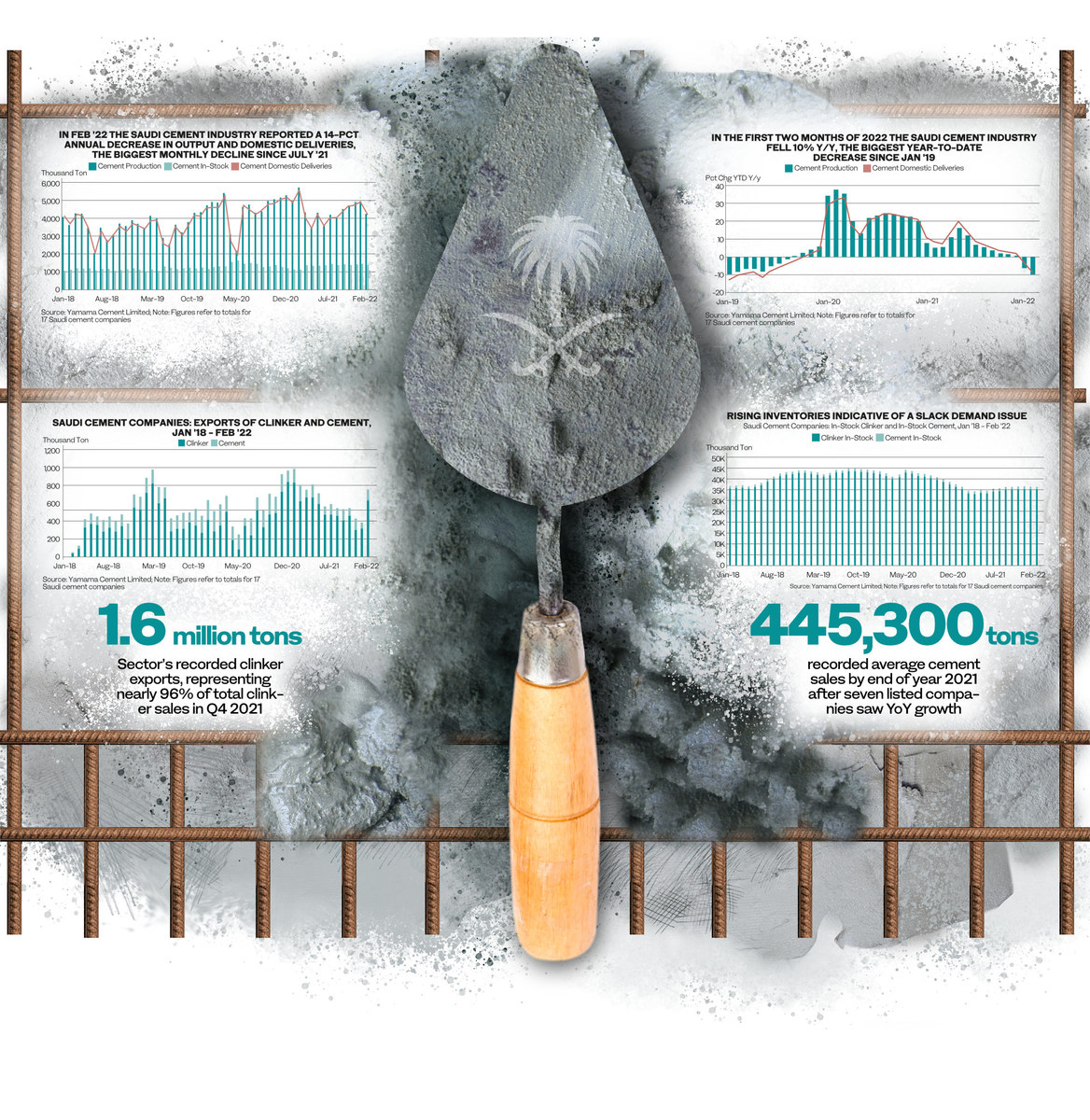
Mazen Al-Sudairi, head of research at Al Rajhi Capital, expects construction activity to boom on the back of rising commodity prices that have soared significantly this year, according to a cement report released by the asset management firm in late March.
“We also expect the inflationary trend to cap cement demand, as we expect cement sales will be flat to negative in 2022, compared to 2021, and constrain an increase in cement prices,” he said.
Although Al-Sudairi sees the financial performance of the cement sector improving, he expects improvement to be capped by weak demand and pricing conditions.
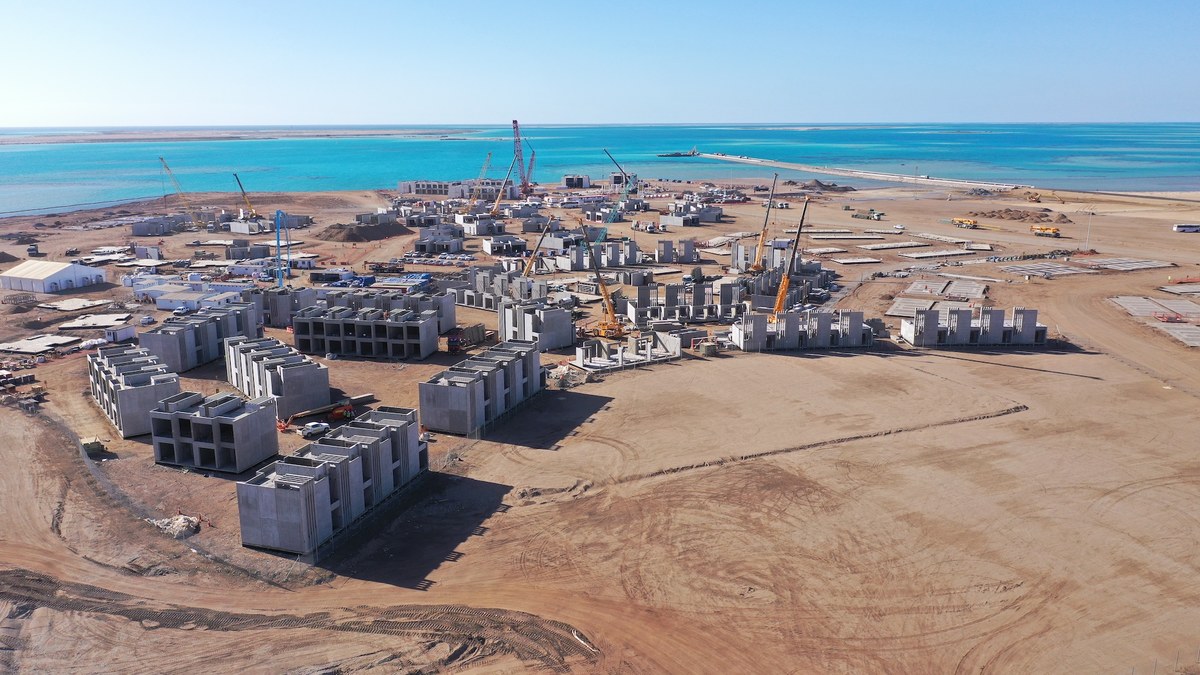
Construction work at labor village in TRSDC
Suspended capacities
The cement market in Saudi Arabia is concentrated with 17 market players in the country, according to Argaam.
Saudi-based Al-Emar Group Chairman Abdullatif Saleh Alsheikh points out that the country’s cement companies are currently operating at around 60 percent of their total capacity. “This leaves room for growth as companies reach full production potential,” added Alsheikh.
He does not see any new cement factories coming up soon, although some could open branches in the north to meet fresh demand there.
Cement volume for the eight months ending August 2021 increased marginally, by 4.5 percent year-on-year, according to a report by Al Rajhi Capital, released late last year.
The annual average growth rate in the cement industry — calculated by Arab News based on Argaam Investment Company figures — amounted to 3.3 percent.
Last year, the market was weighed down due to the COVID-19 restrictions and the slowdown in development projects. A gradual easing of restrictions and renewed construction, especially in megaprojects, is expected to bolster this year’s cement sector.
Al-Sudairi, in a report released last September, forecasted a recovery for the cement industry in 2022. He attributed this to projected spending growth to execute various mega and giga projects across the country. “These, in turn, are likely to aid in the recovery of construction product. However, these will take time to aid cement volume,” he noted.

Mazen Al-Sudairi
The cement industry witnessed slow growth and contractions in 2021, except for April and May.
Cement volume growth in April and May of 2021 was at 41 percent and 65 percent, respectively, year-on-year, according to Al-Sudairi.
“The growth for these two months was primarily driven by a lower base during the previous years due to COVID-related lockdown and travel restrictions. Excluding these months, cement sales would have been lower compared to the previous year,” he underlined in his report released last year.
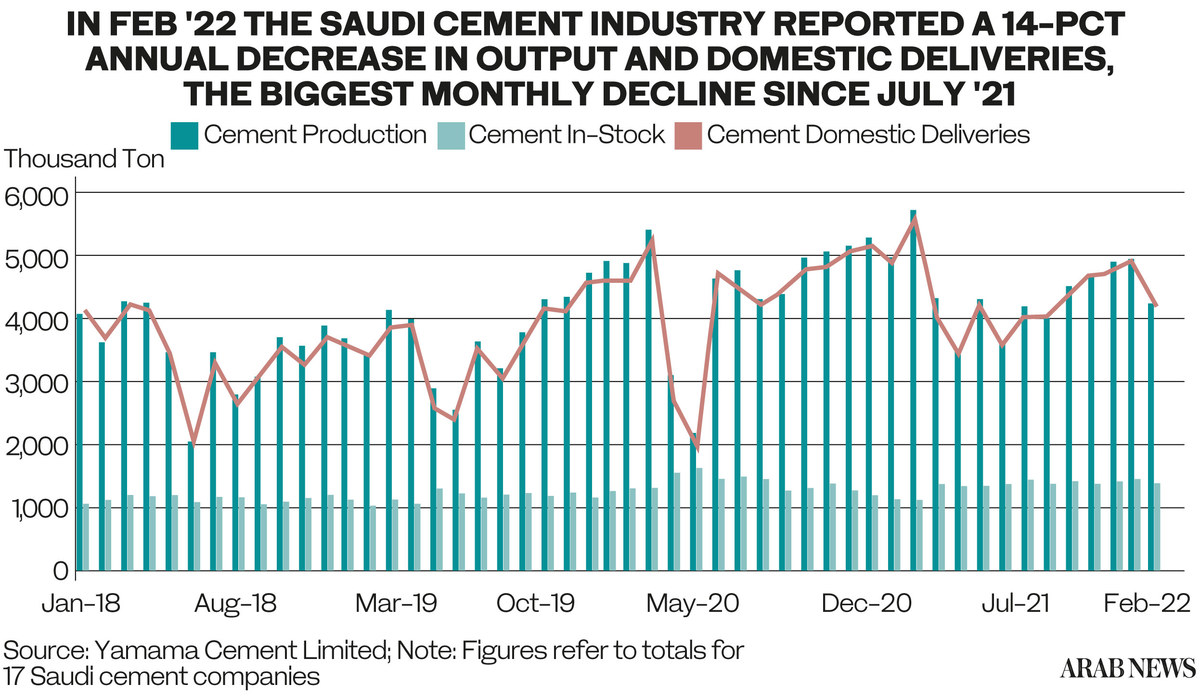
Sluggish returns
Additionally, the cement industry witnessed heavy contractions over the last quarter of 2021. As an example, the aggregate sales of 17 Saudi cement producers decreased 6 percent to 4.9 million tons in January 2022, compared to 5.2 million tons in the same month the year before, according to a report by Argaam.
Total sales decreased 7 percent to 4.8 million tons in December 2021, from 5.2 million tons in the same month the year before. In November 2021, cement sales fell 5 percent to 4.7 million tons in November, compared to 4.9 million tons in the same month year before. They dropped even further to 10 percent and 4.5 million tons in October, compared to 4.9 million tons a year earlier.
This south-bound trend was reflected in Saudi companies’ profits, as the overall profit of 14 Saudi-listed cement companies dropped 29 percent in 2021 as revenues fell on the back of lower selling prices.
FASTFACT
Increase in cement volume for the eight months ending August 2021 increased marginally, by 4.5 percent year-on-year, according to a report by Al-Rajhi Capital, released late last year.
The cement majors posted a collective profit of SR2.5 billion ($667 million) during the year, down from SR3.6 billion a year ago.
For example, a leading industry player, Saudi Cement, recorded a 27 percent decline in profit to SR332 million in 2021 due to a 10-percent drop in revenue.
Similarly, Najran Cement, Yanbu Cement, Qassim Cement, City Cement, Umm Al-Qura Cement, Eastern Province Cement, Saudi Province Cement, Tabuk Cement, Yamama Cement and Hail Cement all witnessed profit declines.
However, Northern Region Cement bucked the trend as its profit remained almost unchanged at SR107 million, even as sales dipped. Al-Jouf Cement, on the other hand, widened losses from SR98 million to SR150 million in 2021.
A drop in sales may not have been the only factor in companies’ profitability.
Riyadh Cement and Arabian Cement saw higher sales by 14 and 19 percent, respectively, and still recorded lower profits.
In the case of Yamama, although the company increased cement deliveries to the local market to 5.22 million tons in 2021 from 4.6 million tons in 2020, its sales revenues dropped by 23 percent year-on-year to SR735 million.
This downtrend suggests that in the case of Yamama Cement, the implied average price of one ton of cement on an ex-factory basis fell approximately 30 percent to SR140 per ton in 2021 from SR200 per ton in 2020.
“In our opinion, the fall in cement demand year-on-year can be attributed to lower construction activity due to a shortage in labor supply and the new regulations relating to new building permits,” added Al-Sudairi in the report.
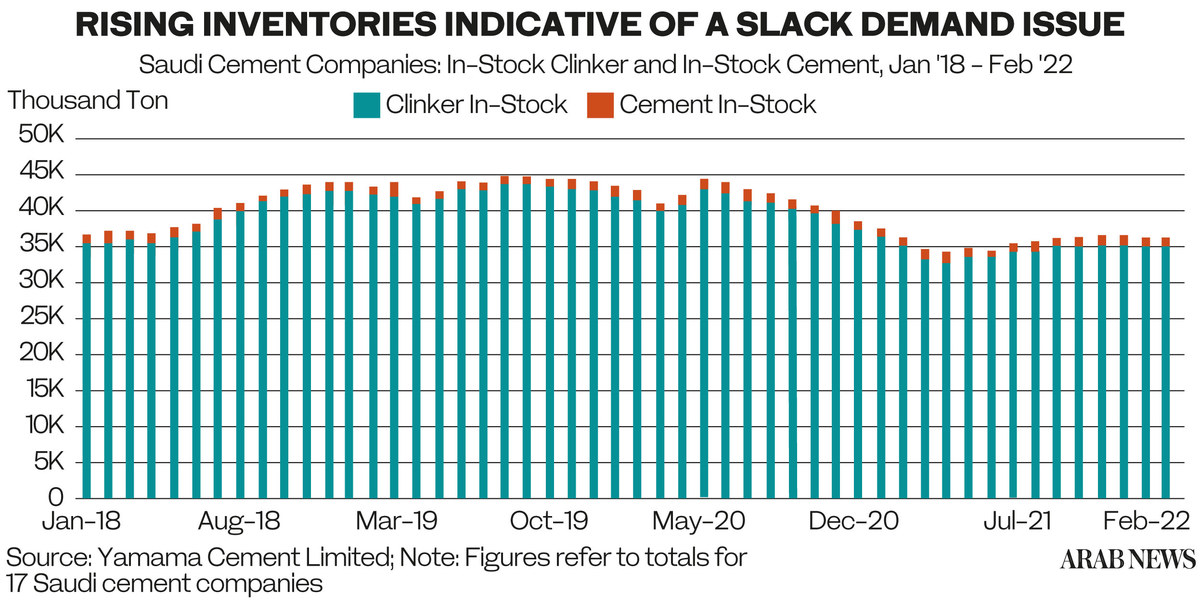
Operational bottlenecks
Other key market challenges and fresh dynamics that are expected to impact the cement industry in Saudi Arabia include the expat levy on foreign nationals and the adoption of greener and newer technology for low-power-consuming plants.
The expat levy on foreign nationals was considered a significant challenge for the cement market in Saudi Arabia, according to a paper titled: “Cement Market in Saudi Arabia – Forecast and Analysis Report 2021-2025.”
“This expat levy is especially taxing on companies that have a workforce comprising more foreign nationals than Saudi nationals,” the paper stated.
In terms of new dynamics, the report noted that Saudi’s cement industry is eyeing greener and low consumption factories as fuel and energy costs typically account for 30-40 percent of total production costs.
“As a result, cement vendors in the region are focusing on adopting alternate ways to deal with expected increases in production costs due to higher energy prices,” it added.
Other trends include changes in cement price forecasts. Saudi vendors are further encouraging the launch of new products and expanding their client base after the ban on cement export was lifted. The relaxation in export restrictions aimed to promote the construction industry’s recovery. “If the ban isn’t reimposed, cement prices could go up again,” said Hatoum.
